#disadvantages of Python
Explore tagged Tumblr posts
Text
Day-6: Python Functions
Day-6: Python Fuctions - Python Boot Camp 2023
Introduction to Python functions Python functions are blocks of reusable code designed to perform specific tasks. They allow you to break down complex programs into smaller, manageable pieces. Functions enhance code reusability and readability, making it easier for developers to maintain and understand their programs. In this article, we will explore various aspects of Python functions, from…

View On WordPress
#Built-in functions in Python#Function annotations in Python#Function definition in Python#How to call a function in Python#Lambda functions in Python#Python decorators#Python function advantages#Python function best practices#Python function disadvantages#Python function examples#Python function parameters#Python function scope and lifetime#Python function tutorial#Python functions#Recursive functions in Python
0 notes
Text
This is a fic idea I was discussing a while back on discord that haunts my dreams.
Rogue cultivator Shen Jiu. He isn't allowed to join Cang Qiong, but they don't lock him up for the demonic cultivation. Yue Qi sneaks him a cultivation manual and some cash, and off Shen Jiu goes into the world.
His cultivation isn't a contest, it's just whatever gets him out alive on the other end. Without a spiritual sword, he uses his environment (pocket sand). The last thing someone threatening him on the road will see is him bending over to sniff a flower, brush his fingers across a pine branch, or stick his hand in his pocket. He kills a moon python rhino by filling its lungs with grass and leaves, no impressive show of qi or weapons necessary.
It's hard to say what level he's at - others knowing would be a disadvantage so you'll never know.
He does all kinds of gigs: accounting, ghost hunting, disappearing shitty dudes who cause trouble for his jiejies at the brothels, monster hunting, or even your +1 at a fancy party to make your X jealous. He's a chameleon, able to banter with the street kids one second then argue philosophy the next.
What to do with this version of Shen Jiu? No idea.
56 notes
·
View notes
Text
Day 1: Apollo

Interpretation notes and trivia under the cut!
His interpretation for my work is based very much around the concept of his manifestation as the Radiant God of the String. Because of this, quite like Hecate, he’s triple-fold and occupies three major spaces; the string of Fate and therefore prophecy, the bowstring and therefore distance and destruction and the lyrestring and therefore music and order. He’s a somewhat melancholy figure all things considered - Fate and following Fate’s tennants is something that he struggled a lot with as a child and even now as a more mature deity, the only solution he’s truly found is to take things one day at a time. Very diligent and fastidious, he’s a hard worker and tends to put his everything into completing any task set before him which also tends to work to his disadvantage since he’s prone to becoming tunnel-visioned until he’s finished what he said he would finish. His family orchestrated his winter breaks because he had the nasty habit of working himself sick when he was still very young.
Apollo is generally represented by circles in my work - priests of Apollo will be marked with at least three circles on their face and usually wear triangular jewellry (typically earrings or necklace charms) to reflect the triple-nature of their god. His favoured colour is a rich, deep blue and while he typically wears elaborate eye paint, he rarely uses face powders. Wears gem-toned blues for his lips unless in mourning where he will leave himself unadorned and unpainted out of respect.
Some quick trivia:
Was born identical to Artemis even though they were born (years) apart. Had brown hair, wolf’s ears and fangs and horns when he was a child but never manifested those features again after his penance for slaying Python. If he’s very stressed or angry, sometimes his fangs will show. The brown of his hair grew out to blond naturally as he developed and matured as a god.
Proficient in all instruments but has always especially preferred stringed instruments. Truly unmatched with a kithara but only uses it for special occasions and official meetings. Generally prefers his lyre for every day usage
Really good at sewing and braiding strings together due to the exercises he had to do while under the tutelage of the Moirai sisters. Can’t weave since Athena banned him from touching a loom but he does like watching her spin. The one time she caught him trying to replicate her patterns with a needle and thread, she complained to Zeus that he had broken his oath. He teases her about that even now.
Was the last of the Twelve to learn how to read and write because he hates letter systems and finds it too arbitrary. Prior to the collaboration that resulted in written letter systems, everyone was perfectly fine with remembering the important stuff and encoding the rest in artistic format such as tapestries, pottery, furniture and jewellry. Apollo himself has a truly formidable memory since he’s been composing and immortalising the events and histories of the world in song since he was very young. He finds written books very dull but Clio’s very insistent about written histories being important and convenient so reluctantly, he’s given permission for his songs and poems to be -gags- transcribed and written down.
Is only called Apollo by his parents, Artemis and Dionysus. Hermes rarely calls him by name in general and the others, including other siblings like Ares and Athena, have always called him Phoebus. Interestingly, Zeus usually calls him Phoebus but will call him Apollo when they are alone or when he’s being especially serious. Apollo is completely comfortable with either name but he does see Phoebus as a bit more formal than Apollo. (Despite his best efforts, both Calliope and Clio also still stubbornly call him Phoebus though he’s fairly sure it’s mostly because they know it bothers him.)
#ginger rambles#pursuing daybreak posting#apollo#Despite how sparkly the doodle of him is he's actually a pretty serious guy LMAO#Apollo's a lot of fun tbh - he's surprisingly set in his ways and can be very traditional which always catches the younger gods off guard#Hermes is the one who decided to invent a written system because he was completely fed up with having to sing elaborate messages#Apollo's memory is also such that he can recall/replicate things after seeing how it's done but he has to physically do the action#to properly remember it. He sees writing as unnatural and a degree of separation away from#the spontaneity and beauty of storytelling poetry and music so he was really upset about being forced to adapt to it#If I had to describe his personality in one word it would be 'illusive'#Apollo is something different to everyone in his life and while they're all equally genuine they're also equally confusing#He's not even the same type of father to his sons - each of his children have a wildly different experience with him as their dad#Super fun I enjoyed doing this next up is Mr Princey prince himself
43 notes
·
View notes
Text
A review of intersex/intergender flag mashup techniques
I really like it when I can figure out what a new pride flag means just from my knowledge of other flags, and I know I'm not alone on this. For example, here are some flags other people have made that I could immediately figure out were <thing> plus intersex:



So, I've been thinking about how we as intersex flag creators can create hybrid flags in consistent way. I'm most motivated to figure out a recipe for intergender flags: genders that are connected to being intersex.
I assembled a spreadsheet of 66 gender flags, and wrote a Python script to take my csv file, parse it, and use the drawsvg library to draw the different flags in different ways. And then I stared at the results, showed them to friends, and discussed what would be both reliable in terms of producing clear, decent-looking results. (A subset of the results are under the keep reading cut.)
In this post I'm gonna review five mashup techniques that I automated and talk about advantages/disadvantages to each. But first a TLDR: adding yellow border stripes is a simple and reliable way to make an intersex-hybrid flag that is now my favourite (and recommended) way to make a new intergender flag.
For example, here's the interfluid flag (genderfluid in a way that is specifically intersex):

***
Method 1: put a ring on it - advantages: simple to do, simple to understand - disadvantages: incredibly dependent on how well the ring colour works with background stripes, and the number of stripes. Would very roughly estimate only ~20% look decent.
Here's a subset of the results. Some, like genderfaun, look nice, but most look awkward:

A yellow ring is even worse:

I think the purple ring has a bit of potential, but I think it's not really viable for being used as a consistent, procedural way to make intergenders. ***
Method 2: stick a belt on it - advantages: already used for some existing mashups - disadvantages: some other genders are doing similar things, like voidpunk, and a white belt has been used by tons of groups for their mashups (e.g. neurogender).
It looks better than the ring alone, but I was still kinda underwhelmed because of how much it depends on the background stripes to not clash. Very roughly I'd say about 40% of the total results look good. Again, here's genderfae through paragender for comparison:
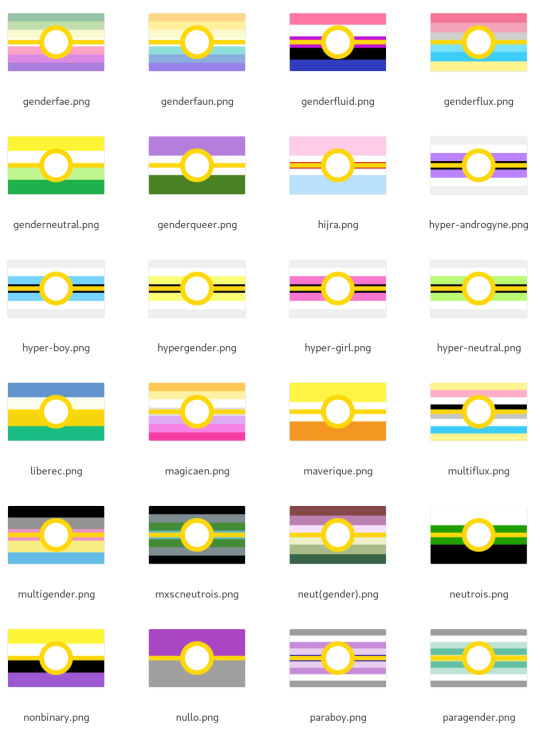
Using a purple belt helps in some cases but makes for some visually busy results:

The purple ones make me think of pokéballs. Again, there are some nice looking ones, but the effect over the whole group was underwhelming. ***
Method 3: inset into the ring - advantages: it's the most clearly "intersex plus X" - disadvantages: hard to read flags where the stripes are similar to each other; might clash with ring colour
When zoomed out like this the results aren't always super easy to read, but overall I'd say this is a reasonably reliably method - very roughly 60% of the results look good to me.
Playing with lightness and contrast on the inset flag likely would improve that number, but my goal here is to compare methods without tweaks.

Insetting into the intergender flag has similar results:

Method 4: add intersex-coloured stripe to the middle - advantage: seems like it would be simple - disadvantage: yellow middle stripe used for pansexual mashups; purple stripe is used in a bunch of of existing mashups - also disadvantage: turns out to actually be complicated in how to do it. Many flags have an odd number of stripes, not all flags have equal-length stripes, etc. I got buggy results on a whole bunch of flags like hijra and hypergirl and honestly if it takes dedicated debugging to fix it's probably too complicated.
When the original flag has an odd number of stripes, I doubled the original middle stripe up and this only works if there's a symmetry to the flag and all the stripes are of equal size.
The results are kinda busy. It looks good to my eyes very roughly 1/8 of the time (~12%) (I did an alternate version where I doubled the purple stripe around the original middle stripe and it's way worse.)
Purple stripe:
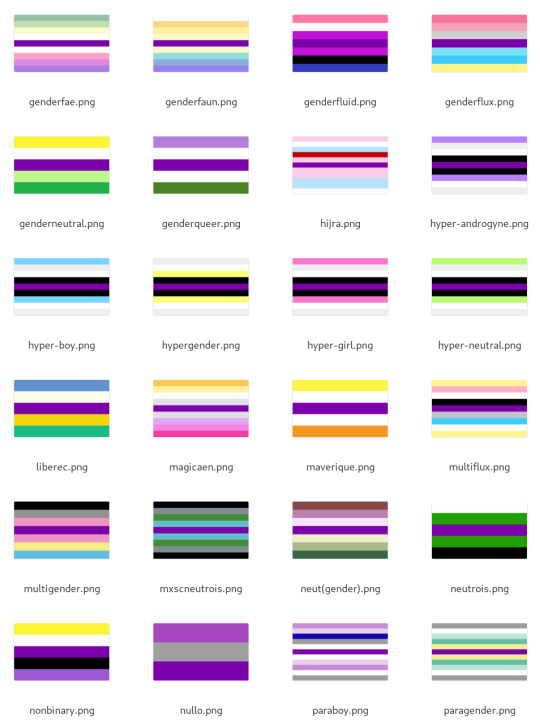
Yellow stripe looks less busy but more confusing:

Method 5: add border stripes with intersex colours - advantages: simple - disadvantages: maybe not as obviously intersex
I honestly didn't expect to like this one, but it has turned out to be my favourite. It works really reliably, like ~90% of the time, and it's distinctive.
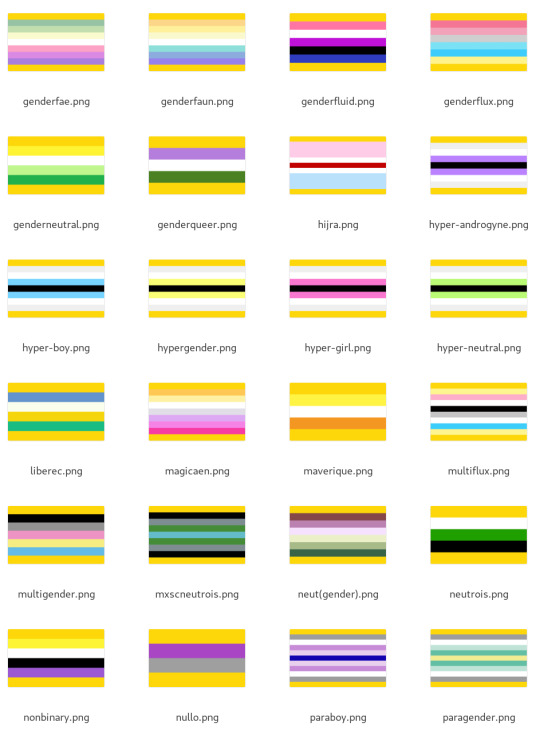
Surprisingly, using purple gives a really different vibe. It kinda makes me feel claustraphobic:
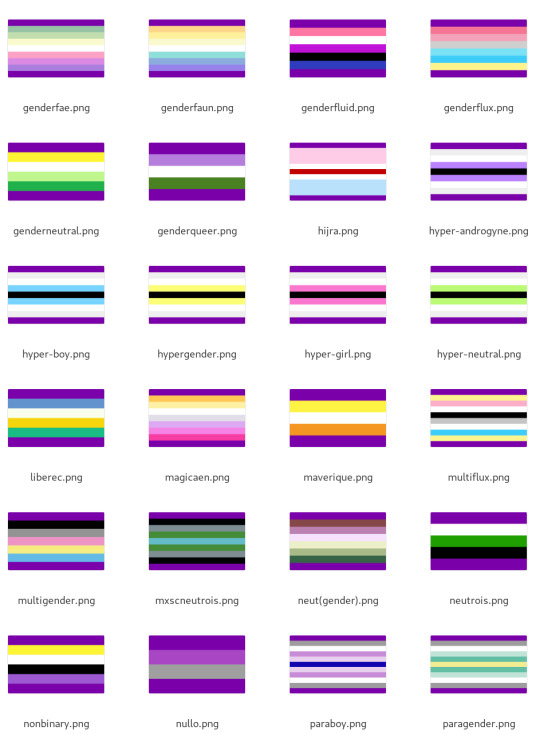
Method 6: change the colours
This one I don't have automated results to share (at least not yet). Right now there are flags like how ultergender recolours the trans flag, that could serve as a template for recolouring.


This is much more complex computationally - I spent a bunch of time playing around with different colourspaces (HSV, LCH, oklab, okLCH) to try to do this automatically and have concluded that this actually a difficult computational problem and not feasible as a widescale recipe.
Part of why the ultergender recolouring works is there are just two colours to recolour. How should one recolour the genderfluid flag? The demigender flag? It's possible to create a convention but not something I'm up to this moment.
I think recolouring is better suited to creating entirely new identities (like ultergender) rather than intergenders that are "<gender> but in an intergender way". ***
Discussion
My goal in all of this has been to try and identify some reliable recipes for creating hybrid flags particularly for intergenders.
My entirely subjective and imprecise estimates of how reliably each method yielded a decent-looking result were: 1. Add yellow border: ~90%-ish 2. Inset: ~60% 3. Belt: ~40% 4. Ring: ~20% 5. Add middle stripe: ~1/8-ish
I was honestly surprised at how much I liked the yellow border method and the friends I've shown it to so far have liked it as well!
I'd like to propose adding yellow border stripes as a recipe for creating intergender flags. This is already in use for interfluid (genderfluid in a specifically/uniquely intersex way):

Indeed, it's the only one of the mashup functions I wrote that yields something for genderfluid that I actually like:

Extrapolating, here are examples of some gender coinings that I think would work: Interdemigender: demigender in a specifically/uniquely intersex way and/or demigender in a way linked to being intersex/intergender



Intervaguegender: vaguegender in a way that is specifically intersex, such as in a way that is connected to being intersex (i.e. one's gender is vague not just for being neurodivergent but also intersex)



I think it works well! I hope you like it! Let me know if you have any feedback. If there are other mashup techniques I didn't think of, let me know. :)
#intersex#actually intersex#mogai#flag design#flag design tips#intergender#PS yes I know the nullo flag should be diagonal stripes
45 notes
·
View notes
Text
Benevolent Heretics
I started writing this the other day and didn't stop until it was done. Can it please happen IRL? I plucked an older character, Vera, from this dream-turned-story and here she is, a bit older and bolder but still somewhat self-conscious.
If it was a waiting room, it certainly didn't feel like any I'd ever occupied. First of all, there was complimentary coffee. Don't misunderstand me, though--it wasn't a slender Keurig sitting next to some Styrofoam cups. There was an actual barista with beautiful taupe skin, box braids, wide-leg jeans and a crop top that said "Hillman College." There was a fancy La Marzocco espresso machine and freshly baked pastries. The lemon basil mini bundt cake looked delicious but I couldn't bring myself to eat. That, and the��pastries weren't free and I'd almost gambled all of my paycheck on this visit, hoping for, but not counting on, reimbursement from my insurance. I eyed the dry erase board of specialty drinks, trying to read through ingredients quickly so the barista wouldn't become impatient.
"Baby, you can take your time," she said. "I love your hair, by the way. What do you call that color? It's like there are little specks of gold in the blue when you turn a certain way."
I beamed. "Thank you so much. Lapis lazuli."
"Oh, perfect!"
"Do you have a favorite scene in A Different World?
"When Diahann Carroll is telling Dwayne Wayne to just die," she said without missing a beat.
I laughed. "Oh, I suppose I wanna try a hot Purple Haze?"
"Medium or dark roast?"
"I guess medium?"
I stared at the art behind her. It depicted a dark-haired white man sitting in a booth, a sort of frustrated expression on his face. Seated next to him was a great blue heron that almost seemed to be wearing a smile. So strange.
"And what's your favorite scene?" she asked, setting the drink in front of me, little purple crystals sitting on top of the cloud-shaped foam art. "Lids are on the counter to your right."
At that moment, an older middle-aged woman opened the door across the room, said, "Vera?" and looked in my direction. I took her in for a second. Her long, curly brown hair cascaded over a kaftan with, was it narwhal print? The straps on her sandals were ocean waves.
We made eye contact. "Ready for you," she said, smiling airily.
"Oh!" I said. 'Ok." I grabbed my drink and started walking toward her, then recalled the question. Before I disappeared down the hallway behind the woman, I turned and called out, "When Lena is explaining the balcony scene in Romeo and Juliet!" I thought the barista was smiling but it was hard to say.
The hallway was a bit of a labyrinth, but every twist and turn had a surprise. The first treat was a banana ball python in a terrarium. "That's Bert," the woman said, turning back to glimpse my face. "Ernie's at the vet overnight, but he's fine."
"Oh that's adorable!" I exclaimed, sipping my lavender and chamomile latte.
"By the way, I'm Celeste," she said warmly. "It's great to meet you in person." She reached for my hand, her bangle bracelets clanging against each other.
"You're the lady I talked to all last month!" I blurted out. I took the hand she offered, and she gently placed her other hand on top of mine, soft and smelling like jasmine.
I looked up at her, then down at my feet. This woman knew just about everything...about one thing. But it was one of the most important things in my life. It felt frighteningly vulnerable. I racked my brain to recall what I knew about her so I'd feel less disadvantaged. It felt like I was running a search in Windows for "celeste" and opening every relevant file of hundreds, not quite knowing what I expected to find. I knew she was married and had two black labs. She started out as a physical therapist and then decided to specialize in....whatever this was. My own physical therapist had recommended her. She loved David Lynch films, Isabelle Allende novels, and lots of Brazilian bossa nova singers I'd never heard of. She loved Italian restaurants but never ordered spaghetti because "you can make that much better at home." She sang in the choir at the Unitarian church down the road. She researched everything she bought to ensure it was vegan. She had family in Washington, the state. She really liked Animal Farm when she read it in school, too. Everything I knew about her felt so surface level compared to everything she knew about me. And some of what I knew was from doing my own internet research, if I was honest. She let go of my hand and I shuddered for a second when she turned and said, "Just a bit further; we're almost there," and kept walking.
Up ahead, I saw that the walls turned into aquariums full of colorful fish: gouramis, oscars, cichlids, danios, and barbs. I stood mesmerized as she opened a door and motioned for me to step in front of her. "The fish are always a big hit," she said. I followed her into an office-like room with a very 70s vibe. The groovy aesthetic went so far that it had one of those conversation pits with an orange plaid couch and bookshelves. I started reading titles and spotted I Can't Date Jesus and A Queer and Pleasant Danger. She stepped down onto the couch, sat down, and started writing notes in a little pad.
"You can sit," she said, noticing how I was just standing there, my eyes flitting from macrame hanging pots to lava lamps to fabric posters, overwhelmed by all the mustard yellow, avocado, and earthy brown tones everywhere.
I rubbed my sweaty hands together and sat several feet away from her on the same side of the square-shaped couch. I looked her way and my eyes fixated on her turquoise necklace and the movement of her chest as she breathed. My eyes travelled up and I searched for a neck pulse, then quickly looked away as soon as I realized what I was doing. She stopped writing and looked straight at me. "Whatever you're thinking is ok here," she assured me. "Nothing to feel self-conscious about."
"Do you see a lot of people like me?"
"In what way? Do you mean cardiophiles? If so, not a lot, but you're not the first."
I let out a long sigh. "There's not a day that goes by that I don't think about this," I confessed.
"And there's nothing wrong with that. It's more common than you think, even more so for neurodivergent people like yourself."
"I prefer 'neuro spicy,'" I chuckled. She smiled, nodded.
"Is your heart beating fast, Vera?" she asked plainly. It was a simple question, but as soon as she uttered it, the words stretched out in my brain like cold cane syrup. I stared into her eyes and heard the words "heart" "beating" and "fast" over and over again for several seconds. I was so entranced that I didn't hear myself say, "Yeah. It is," until it had already escaped my mouth.
She laughed casually. "And that's perfectly normal. The last time we had a cardiophile here, he was an older man, many years ago. He was recovering from cancer treatment--that was what led him to physical therapy, and then to me. I started out as a more traditional physical therapist, and in my practice I learned about the more unusual ways that physical intimacy healed--for those who have interests that aren't mainstream, and nonsexual kinks, if you will. It works in tandem with conventional physical therapy. I set my own boundaries because I have to, and they are firm, but you might be surprised how much one can do with clothes on, and how gratifying that can be for the client. I don't have a personal investment in most of the services I provide here, but in my line of work I've become deeply interested in sensuality and the multitude of ways that humans experience it. The pre-visit chats are designed to help us feel comfortable with each other, and if you're wondering--yes, they are covered under your insurance, as are our in-person appointments. As long as your therapist and I can justify to the insurance company that you're making progress, they will provide at least partial coverage."
"What if...I no longer need physical therapy but I still want to come here and do this?"
"Many people do, and you can discuss payment plans with Yasmin up front. She's the barista who served you."
"Oh wow. Ok, great."
"Do you want to play music? Since your interest is largely about listening and being listened to, I know that might be a distraction, but I could play it at a low volume. Also, this is something we ask every client."
I nodded, and she continued, "We have a record player and mostly 70s music to fit with the room's motif, but if you want something else, I should be able to pull it up for you."
I only thought about it for a moment. "Do you have Fleetwood Mac's Tusk album?"
She nodded, ascended the two steps that led out of the conversation pit, and crossed the room to an refurbished old phonograph with an oak horn. She flipped through a crate of records and within a minute had retrieved Tusk. "For the longest time, it was all about Stevie for me," she said. "And then, I don't know, I was at a party and they were playing Mirage. Somehow I'd never heard 'Hold Me' and I just thought Christine and Lindsey's voices blended so well. I love all of Christine's tracks on Mirage now, even the cheesiest." I smiled at this anecdote, closed my eyes and listened to the soft whine of Lindsey's slide guitar. Christine's vocals came in as smooth as honey, and I thought about how a song with such insecure lyrics could be so soothing sonically. The sound mattered much more to me.
She reached into an armoire and pulled out a cardboard box. She placed it beside me as she stepped back down into the pit. "You can pick out a stethoscope from there. Or like I said the other day, you can bring your own. I just need an extra minute to sanitize it. Just standard procedure," she shrugged. I rifled through several stethoscopes and pulled out a Littmann with a rose gold teardrop-shaped chest piece and a pink satin finish.
"It's like if Glinda had one," I heard myself saying.
"You liked Wicked?" she asked. "I need to find time to go see it."
"Oh it's sooooo good," I told her.
"Alright, so we have thirty minutes left. I'll lead the session, but your job is also to let me know if there's anything else you need or if you're uncomfortable. In the case of the former, I'll see if I can accommodate, and in the case of the latter, we will stop and discuss what needs to change. Does that make sense?" I nodded. "Ok, if you don't mind, I need you to unbutton the second button on the top of your shirt." I did as she asked, all the while wondering if she could see my heart pounding. My chest was small, so I wasn't revealing any cleavage, but my thin build almost made it easy to see through. She slowly placed the palm of her hand over my heart and kept it there for a few seconds. "I can feel it; it's so fast," she remarked. The practiced smile on her face really only indicated a passing, and I suppose professional, interest in my heartbeat, but that was enough for me.
By the time she was wearing the binaurals and positioning its chest piece on my bare chest, the frantic, rushed "The Ledge" was playing and my heart pounded along with Lindsey Buckingham's bass. Unlike any doctor I'd ever seen, Celeste moved the chest piece all around the terrain of my chest, stopping for a bit at each location to hear what my valves would do. I took deep breaths without realizing it, and I looked down to see the stethoscope rise and fall with my body. "I haven't listened to a great deal of hearts in my line of work, but this one sounds pretty great to me." I looked over at her face, the metal tubes peeking out from behind her hair. There was something so reassuring about looking at someone wearing binaurals like that, knowing they were listening to me. I saw her eyes on her phone and wondered what she was looking at until she said, "109, how about that? That's pretty fast for resting. I'm glad I've gotten your heart to engage with me so fully." I thought I would melt. When she was finished listening, "Think About Me" had played and the mercifully short "Save Me a Place" had just ended.
"Would you like to listen to my heart?" she asked. "It's a little fast because I think it has reacted to yours. Just a heads up. You're welcome to listen if you'd like. But also know that it's ok with me if you don't want to. Either way."
"Can I lay down on the sofa while I'm listening?"
"Absolutely, let me grab one of the throw pillows for your head."
The entirety of "Sara" played while Celeste held the chest piece under her narwhal kaftan and I closed my eyes while facing the ceiling. I mean I knew that "Sara" was the next cut on the record, but the noise-cancelling feature of the stethoscope worked so well that I couldn't even tell music was playing. I just heard her fast heartbeat layered with her steady breathing. For a moment, I wondered how old she was. At least mid-50s, probably? Maybe older. Definitely at least ten years my senior. And all the while, I thought to myself, she'd had this organ working inside of her all the time. Unless she'd had a transplant, I reasoned. But my mind didn't dawdle on those thoughts. With my eyes closed, I could imagine I was swimming, or hiking, or biking. I settled on imagining I was floating in a blue lagoon, seeing a waterfall up ahead. I swam a leisurely breaststroke to the waterfall and let it pour all over my body. And then my mind just went blank. There was just nothing--except for the sound. And the sound was crystal clear and exquisite. I didn't realize how much time had passed and was surprised to hear "but never have I been a blue calm sea," when I took the stethoscope off. We were already at the end of "Storms"?
I sat up, turned around, and saw that Celeste was smiling so warmly I could've mistaken this scene for a Hallmark movie. My brain wanted to stop and take a screenshot of the moment she handed me the other end of the instrument and our hands were both touching it--hers a deep olive, mine rosier. My hands were unadorned but she wore delicate little rings with tiny rhodolite and hematite stones. "You can put it on the end table to your left," she indicated.
"If it was mine it would have a gender and a name and everything," I told her excitedly.
She laughed heartily and I had a revelation that being proud of making your therapist laugh applies to just about all types of therapists. "How was that?" she asked.
"It was wonderful. You sound great. It--it was great," I said with the imagination of a Tumblr bot.
"Did you tell me a few weeks ago you have an electronic stethoscope?"
"Yes--an Eko Core 500 named Christine, actually."
"Feel free to bring her next time." She pulled out her phone. "I have you down for...this time in two weeks. Does that still work for you?"
"Yes, that sounds great," I said like a broken record. I would have more and better words for the experience later.
She asked if I had any questions, and if this was what I'd had in mind. No and a million times yes. We exchanged more small talk about weekend plans--work and a hike for me, house cleaning and possibly seeing Wicked with her partner for her. She walked me back through the labyrinth and I waved goodbye to an indifferent Bert. I made sure to give Yasmin a thumbs up on my drink as I sipped the rest on my way out, and when I stepped out into the chilly December morning, I felt brand new.
#cardiophilia#cardiophile#stethoscopes#auscultation#cardiophile story#cardiophilia story#therapy#70s#Fleetwood Mac#A Different World#1970s
14 notes
·
View notes
Text
Linked List in Python
A linked list is a dynamic data structure used to store elements in a linear order, where each element (called a node) points to the next. Unlike Python lists that use contiguous memory, linked lists offer flexibility in memory allocation, making them ideal for situations where the size of the data isn’t fixed or changes frequently.
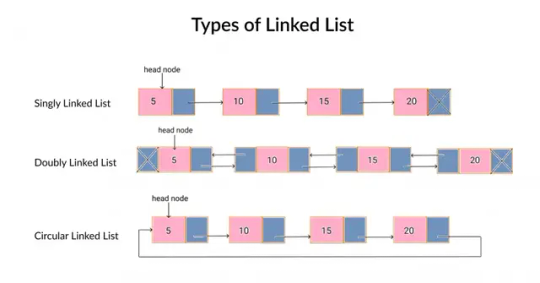
In Python, linked lists aren’t built-in but can be implemented using classes. Each node contains two parts: the data and a reference to the next node. The list is managed using a class that tracks the starting node, known as the head.
Node Structure: Contains data and next (pointer to the next node).
Types:
Singly Linked List
Doubly Linked List
Circular Linked List
Operations: Insertion, deletion, and traversal.
Advantages:
Dynamic size
Efficient insertions/deletions
Disadvantages:
Slower access (no random indexing)
Extra memory for pointers
Want to master linked lists and other data structures in Python? PrepInsta has you covered with beginner-friendly explanations and practice problems.
Explore Linked Lists with PrepInsta
2 notes
·
View notes
Text
Worldbuilding: Running Hot and Cold
So, of the creatures you’ve invented for your world - are they ectothermic or endothermic?
“Cold-blooded” and “warm-blooded” are the colloquial terms for it. They’re... not exactly wrong, but incomplete. A “cold-blooded” critter simply does not have internal workings devoted to keeping it inside a specific band of temperatures No Matter What. (Though some may in fact be able to keep parts of their body much warmer or cooler than their surroundings - see the swordfish, among others, with their rete mirabile of blood vessels to keep their eyes warm in the sea to spot prey.) On the other hand a “warm-blooded” critter (birds and mammals being our key contenders) not only has the inner workings to do so, it absolutely must, or perish.
If you’re not sure what your critter should be, consider that these are two different ways of adapting to life with distinct advantages and disadvantages. Sort out which of those fit your critter best, and you should know what to pick.
First, let’s take ectothermy. As have most animals in the history of the world. It’s the most common way of life for a reason: it works. Since ectotherms rely on the outside world to keep them warm or cool, they don’t need to spend any energy on maintaining a constant internal temperature. This makes needing to eat much, much less of a worry; critical if you’re in a low-prey environment. Full-grown Nile crocodiles can pretty much live on only two wildebeest a year... and guess what? The herd’s migration usually takes them across particular rivers twice a year. Convenient!
(Herbivores prey on plants, algae, etc. Those, too, can be in short supply.)
Three distinct disadvantages, though. First, you have to make proteins that function at a wide range of temperatures; this costs extra resources. Second, your eggs are usually more temperature-sensitive than you are. Finding the right environment for them is critical. Third... if you really really need a fever, say to kill off a bacterial or fungal infection, you have to figure out how to get your environment to do the work. You have to give yourself a behavioral fever. Alligators, crocodiles, and their relatives will all do this by basking in the sun longer and more often than normal.
So. Endothermy. Apparently pounced on by both proto-mammals and some of the dinosaur lineages. This is a very resource-intensive strategy. You have to eat; you have to eat frequently. And if you get just a little too hot or cold inside, you die. A snake that drops down to 50 F inside may be perfectly fine, though it probably doesn’t want to freeze. A human whose internal temp drops to 85 F? That is nightmare territory and heading toward death. Why would any creature do this?
Look at the three disadvantages of ectothermy. An endotherm doesn’t make proteins that function across the temperature spectrum; it doesn’t have to. All its building blocks can be finely tuned to the temperature it’s supposed to be, with a little wiggle room in case of, you know, a smidge too cool or too hot. This saves a lot of resources. Sensitive eggs? Can be kept with you, either in a nest you keep warm or even - gasp - internally. (Mammals are so metal.) Fungus and bacteria? Get hit by a blazing reception of fiery fevers and fine-tuned immune systems. They can kill us, but numbers-wise, ectotherms are at far greater risk.
And evolution, very often, is a numbers game. It doesn’t take much of an advantage to pull ahead. It only takes a small, constant advantage over time.
Of course, there are exceptions. Like hibernating hummingbirds (some let their temp drop to 40 F every night) and pythons shivering to keep eggs 5-10 degrees warmer than outside air (as the Everglades snarl in frustration). And then there are paleontologist speculations that the really big sauropods and some other dinosaurs had mesothermy, which doesn’t seem to exist on the planet today because the (probably asteroid impact) disaster at the K-T boundary wiped out every critter past a certain size, and you had to be sauropod-size to make it work.
Consider all these, when you make up a critter for your characters to deal with. It matters to how they behave - and that makes a big difference when your heroes might have to run through a pack of them!
7 notes
·
View notes
Note
Theproject but it’s a muppets movie and Shimmer is the only human: thoughts ?
I think it’d definitely work but I also think there are funny options to who could be the human. Like there’s disadvantages and advantages to everyone. Any of the robots being the only human would funny as fuck. Python is the only human and then he does his whole killing himself to turn into a robot thing and he comes back played as a muppet then basil is introduced as the new only human. I think basil being human would be incredible because of her whole obsession with killing her family which I think should be played off completely seriously but her whole family is muppets. She does not mention this. Ares would work well as the only human but I don’t think she should be because it’d work too well. Tenebris/later Pluto as the only human maybe? I don’t know. You’ve created such a beautiful world there’s so much you could consider
3 notes
·
View notes
Text
Mastering Data Structures: A Comprehensive Course for Beginners
Data structures are one of the foundational concepts in computer science and software development. Mastering data structures is essential for anyone looking to pursue a career in programming, software engineering, or computer science. This article will explore the importance of a Data Structure Course, what it covers, and how it can help you excel in coding challenges and interviews.
1. What Is a Data Structure Course?
A Data Structure Course teaches students about the various ways data can be organized, stored, and manipulated efficiently. These structures are crucial for solving complex problems and optimizing the performance of applications. The course generally covers theoretical concepts along with practical applications using programming languages like C++, Java, or Python.
By the end of the course, students will gain proficiency in selecting the right data structure for different problem types, improving their problem-solving abilities.
2. Why Take a Data Structure Course?
Learning data structures is vital for both beginners and experienced developers. Here are some key reasons to enroll in a Data Structure Course:
a) Essential for Coding Interviews
Companies like Google, Amazon, and Facebook focus heavily on data structures in their coding interviews. A solid understanding of data structures is essential to pass these interviews successfully. Employers assess your problem-solving skills, and your knowledge of data structures can set you apart from other candidates.
b) Improves Problem-Solving Skills
With the right data structure knowledge, you can solve real-world problems more efficiently. A well-designed data structure leads to faster algorithms, which is critical when handling large datasets or working on performance-sensitive applications.
c) Boosts Programming Competency
A good grasp of data structures makes coding more intuitive. Whether you are developing an app, building a website, or working on software tools, understanding how to work with different data structures will help you write clean and efficient code.
3. Key Topics Covered in a Data Structure Course
A Data Structure Course typically spans a range of topics designed to teach students how to use and implement different structures. Below are some key topics you will encounter:
a) Arrays and Linked Lists
Arrays are one of the most basic data structures. A Data Structure Course will teach you how to use arrays for storing and accessing data in contiguous memory locations. Linked lists, on the other hand, involve nodes that hold data and pointers to the next node. Students will learn the differences, advantages, and disadvantages of both structures.
b) Stacks and Queues
Stacks and queues are fundamental data structures used to store and retrieve data in a specific order. A Data Structure Course will cover the LIFO (Last In, First Out) principle for stacks and FIFO (First In, First Out) for queues, explaining their use in various algorithms and applications like web browsers and task scheduling.
c) Trees and Graphs
Trees and graphs are hierarchical structures used in organizing data. A Data Structure Course teaches how trees, such as binary trees, binary search trees (BST), and AVL trees, are used in organizing hierarchical data. Graphs are important for representing relationships between entities, such as in social networks, and are used in algorithms like Dijkstra's and BFS/DFS.
d) Hashing
Hashing is a technique used to convert a given key into an index in an array. A Data Structure Course will cover hash tables, hash maps, and collision resolution techniques, which are crucial for fast data retrieval and manipulation.
e) Sorting and Searching Algorithms
Sorting and searching are essential operations for working with data. A Data Structure Course provides a detailed study of algorithms like quicksort, merge sort, and binary search. Understanding these algorithms and how they interact with data structures can help you optimize solutions to various problems.
4. Practical Benefits of Enrolling in a Data Structure Course
a) Hands-on Experience
A Data Structure Course typically includes plenty of coding exercises, allowing students to implement data structures and algorithms from scratch. This hands-on experience is invaluable when applying concepts to real-world problems.
b) Critical Thinking and Efficiency
Data structures are all about optimizing efficiency. By learning the most effective ways to store and manipulate data, students improve their critical thinking skills, which are essential in programming. Selecting the right data structure for a problem can drastically reduce time and space complexity.
c) Better Understanding of Memory Management
Understanding how data is stored and accessed in memory is crucial for writing efficient code. A Data Structure Course will help you gain insights into memory management, pointers, and references, which are important concepts, especially in languages like C and C++.
5. Best Programming Languages for Data Structure Courses
While many programming languages can be used to teach data structures, some are particularly well-suited due to their memory management capabilities and ease of implementation. Some popular programming languages used in Data Structure Courses include:
C++: Offers low-level memory management and is perfect for teaching data structures.
Java: Widely used for teaching object-oriented principles and offers a rich set of libraries for implementing data structures.
Python: Known for its simplicity and ease of use, Python is great for beginners, though it may not offer the same level of control over memory as C++.
6. How to Choose the Right Data Structure Course?
Selecting the right Data Structure Course depends on several factors such as your learning goals, background, and preferred learning style. Consider the following when choosing:
a) Course Content and Curriculum
Make sure the course covers the topics you are interested in and aligns with your learning objectives. A comprehensive Data Structure Course should provide a balance between theory and practical coding exercises.
b) Instructor Expertise
Look for courses taught by experienced instructors who have a solid background in computer science and software development.
c) Course Reviews and Ratings
Reviews and ratings from other students can provide valuable insights into the course’s quality and how well it prepares you for real-world applications.
7. Conclusion: Unlock Your Coding Potential with a Data Structure Course
In conclusion, a Data Structure Course is an essential investment for anyone serious about pursuing a career in software development or computer science. It equips you with the tools and skills to optimize your code, solve problems more efficiently, and excel in technical interviews. Whether you're a beginner or looking to strengthen your existing knowledge, a well-structured course can help you unlock your full coding potential.
By mastering data structures, you are not only preparing for interviews but also becoming a better programmer who can tackle complex challenges with ease.
3 notes
·
View notes
Note
malware is different to Python in the sense that he’s designed to be capable of mimicking a human but to abandon that the second it’s limiting him. you could put your hands in that machinery but one small step one and it’d end up cutting your hand off like a knife through thin air. his human skin mimic is also not fully joined together and leaves gaps at the joints. Just a collection of facts I thought would be interesting
Ooooh indeed it is ! That’s fun . It also implies Python hangs onto humanity even if it puts him at a disadvantage which . I have incredible amounts of feelings about .
7 notes
·
View notes
Note
🍪(5)
"Hello there. Sir Lukas, yes? Or... Sir Lukas, was it? I do not believe we've formally met." He bows. "I am Azama, a humble monk from Hoshido's mountains."
Eyes crinkle at the corners from a light smile.
They may not have met, but that does not mean a certain knight in red, occasionally in proximity to a one in blue or another in green, has escaped the monk's notice.
"Back home, there's a tradition on this very day that many have seen fit to bring back to life here at Garreg Mach. Perhaps you've heard of it?"
Stick of biscuit and chocolate is waved in offering.
What's a friendly little game between coworkers, anyhow? Get to know one another just a smidgen better?
"Hm, hmm~ Care to play a bout?"
He hides a titter behind his hand.
"Unless you're too shy to play with an acquaintance, that is..."
Roll: 5
"In another life, yes, but here, just Lukas will do," he responds, polite even as he sizes the other man up. Lukas had heard of this Azama before, but they had not crossed paths until now -- which was quite the interesting way to finally meet the other man.
Well, proper or not, it seemed they'd be getting to know each other one way or the other.
Lukas returns the man's bow with a reserved one of his own, trying to get a good read on him but struggling to see anything aside from lighthearted trickery not out of place for the day. "Azama, it's good to finally make your acquaintance. I've heard much about you, and I was beginning to think you might have been more myth than man."
"Oh? So this originates from your culture? Perhaps you could tell me more sometime -- for now, however, you've thrown the gauntlet, and I do not shy away from a challenge once given," Lukas muses, amusement layered over the faint competitive edge in his words. This was just a silly game, but he wasn't one to back down easily and he would admit to wanting to test what this Azama was all about -- even if only a little.
How far was he willing to go for a little teasing?
Lukas does see before they've even begun that he'll suffer the same disadvantage of height that he had with Python, but chooses to force a remedy for it instead of attempt to meet the difference on his own. With a practised calm he reaches out to gently grip the other man's clothes, physically guiding him to bend slightly so that they're now eye to eye with a placating smile.
"Whenever you're ready," he hums, taking one end of the biscuit into his mouth, red gaze steady against the amused squint of his challenger.
It seemed neither one of them was about to break, both making their way through the chocolate covered biscuit without a hint of hesitation. An intense stalemate. And, inevitably, they met in the middle with the flattest, least charismatic press of lips imaginable. Still matching each others' gaze -- at least as far as Lukas could tell -- the little crick of the biscuit splitting cleaning between them seeming to go utterly ignored as their stare down continued.
Lukas did eventually break off his hold on the other man's clothing, allowing him to right himself, and pulled away from the slightly chocolatey but definitely crumbly biscuit kiss -- though he did not allow his gaze to shift away from Azama's face.
"I believe that's a draw."
6 notes
·
View notes
Text
Meet Owen
Maximoff-Romanoff
• 12 years old
• biological child of Wanda and a male donor
• is very awkward
• will literally try to avoid any situation if possible
• he also has asthma which is pretty severe
• both his moms, Ben and Charlie carry an inhaler anywhere they go
• Owen obviously too
• goes to a private middle school next to the twins' high school
• is in 7th grade
• comic book lover
• Owen and Liam have a secret comic book stash hiding under Liam's bed
• it's hiding in there because Natasha and Wanda think that some comic books are too extreme and graphic for them
• by the age of 9, Owen had taught himself several programming languages, including Python and JavaScript
• he uses these skills to build games or apps of his own
• he's very (VERY) smart and talented
• finds school boring since he has studied almost
anything that is being taught, at home when younger
• so he doesn't really make an effort and has „ok" grades when they could be much better
• his moms are fine with it though, they know what he's capable of
• despite his love for technology, Owen finds peace in nature
• him and Wanda go out for a morning walk everyday before school
• they just like to talk
• Owen usually geeks out about some tech or new programming language he plans on learning
• Wanda is just happy to listen even though she doesn't understand anything most of the time
• pretty severe medical trauma
• will elaborate on that somewhen
• is OBSESSED with Tony and spends a lot of time with him much to his moms' dismay
Johansson-Olsen
• 12 years old
• third-oldest aka middle child along with Mia
• biological child of Elizabeth and another male celebrity
• doesn't remember his „father" much, since he was just a few months old when they separated
• adores Scarlett
• she's his mom and treats her the same as Lizzie
• goes to a private middle school
• just like „pretend Owen" he is big into technology and computer science and allat
• severe asthma
• prefers solitary activities or small groups rather than large gatherings
• absolutely despises the paparazzi but tries to keep his younger siblings protected and usually puts them before himself
• is Scarlizzie's only kid in elementary school
• he's also bullied
• being the kid of two very well known actresses comes with a liz of disadvantages
• „Your moms fucking suck, Brie Larson is way better", „I bet you only get good grades because your parents can buy anything", „You'll end up just like your Dad", „Who's your real Dad? Couldn't handle you?" and so on
• and he's sick of it
• his teachers don't really do anything
• and he would never tell his parents
• neither Charlie or Ben
• they would just make his situation worse
.・。.・゜✭・.・✫・゜・。.
Face Claim
Walker Scobell




#wanda maximoff#wandanat#elizabeth olsen#mommy natasha#mommy wanda#natasha romanoff#natasha x reader#natasha x wanda
4 notes
·
View notes
Text
Exploring the Pros and Cons of Selenium IDE for Test Automation
Introduction: Selenium IDE, a widely-used integrated development environment for Selenium, has garnered attention among testers for its ability to streamline automated test script creation. While it offers numerous advantages, it also presents certain limitations. In this comprehensive examination, we delve into the strengths and weaknesses of Selenium IDE, providing valuable insights to guide testers in their test automation endeavors.

Advantages of Selenium IDE:
1. User-Friendly Interface: Selenium IDE boasts an intuitive interface that simplifies the process of creating test scripts. Its user-friendly tools for recording and playback make it accessible to testers of all levels, including those with minimal programming experience.
2. Swift Test Development: A notable feature of Selenium IDE is its capacity for rapid test development. Testers can swiftly create automated test cases by recording user interactions with web applications, reducing the need for manual scripting and accelerating the development cycle.
3. No Programming Expertise Required: Unlike some other Selenium tools, Selenium IDE does not demand proficiency in programming languages. Testers can create automated tests without writing code, making it an attractive option for those new to automation or seeking a simplified approach.
4. Cross-Browser Testing Support: Selenium IDE facilitates cross-browser testing, enabling testers to execute test scripts across various web browsers such as Chrome, Firefox, and Safari. This ensures consistent application functionality across different browser environments.
5. Seamless Integration with Selenium WebDriver: Selenium IDE seamlessly integrates with Selenium WebDriver, allowing testers to export recorded test scripts to WebDriver-compatible programming languages like Java, Python, and C#. This interoperability enhances script flexibility and scalability for more complex testing scenarios.
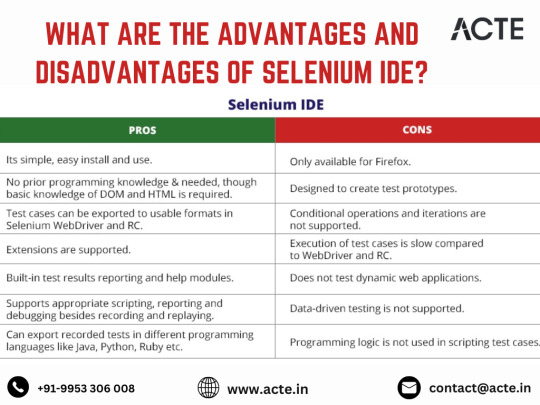
Disadvantages of Selenium IDE:
1. Limited Functionality: While Selenium IDE offers ease of use, its functionality is relatively limited compared to other Selenium tools such as WebDriver and Grid. It primarily focuses on basic test recording and editing, which may not suffice for complex testing requirements.
2. Browser Dependency: Selenium IDE's functionality is dependent on the browser, which can lead to compatibility issues and constraints. Changes in browser versions or updates may impact the reliability and performance of Selenium IDE, necessitating ongoing maintenance and updates.
3. Challenges with Dynamic Element Handling: Selenium IDE may encounter challenges when handling dynamic web elements and complex interactions. Its inability to effectively manage dynamic elements can restrict its usability in certain testing scenarios, requiring alternative approaches or additional tools.
4. Limited Script Reusability: Test scripts created in Selenium IDE may lack modularity and reusability, particularly for large test suites. Managing and organizing test scripts can be challenging, leading to increased maintenance overhead and reduced efficiency.
5. Absence of Native Parallel Testing Support: Selenium IDE does not natively support parallel testing, which may impact test execution speed and efficiency, particularly in large-scale automation projects. Testers may need to explore alternative solutions or utilize other Selenium tools for parallel execution.
Conclusion: In summary, Selenium IDE offers a user-friendly platform for automated test script creation, making it a valuable tool for testers across various skill levels. However, its limitations in terms of functionality, browser dependency, and lack of advanced features may pose challenges for complex testing scenarios. Testers should carefully evaluate the strengths and weaknesses of Selenium IDE to determine its suitability for their specific testing needs and project requirements.
2 notes
·
View notes
Text
Unraveling Selenium's Testing Odyssey: Pros and Cons Unveiled
In the ever-evolving realm of software testing, Selenium stands as a stalwart, renowned for its versatility and capabilities. As testing teams explore this dynamic tool, it's essential to navigate through its strengths and challenges. This exploration takes a deep dive into the advantages and disadvantages of Selenium, offering insights into what makes it a formidable ally and where it presents potential hurdles.

Pros of Leveraging Selenium:
Seamless Cross-Browser Compatibility: Selenium's prowess lies in its ability to seamlessly support an array of browsers, including Chrome, Firefox, Safari, and Edge. This ensures that web applications undergo thorough and consistent testing across diverse user environments.
Flexibility in Programming Language Support: A distinguishing feature of Selenium is its support for various programming languages – Java, Python, C#, and Ruby. This adaptability empowers testing teams to choose languages that align with their expertise or project requirements, fostering a dynamic and adaptable testing environment.
Efficient Parallel Execution: Selenium's capability to execute test scripts in parallel enhances efficiency, especially when dealing with extensive test suites. This feature significantly reduces the time required for test runs, a crucial aspect in meeting tight development timelines.
Robust Community and Abundant Resources: Beyond its features, Selenium thrives on the strength of its community. A vibrant and vast user community, coupled with an abundance of online resources, ensures quick problem-solving, continuous updates, and a wealth of knowledge accessible to testers at all skill levels.
Seamless Integration with Test Frameworks: Selenium effortlessly integrates with popular test frameworks like TestNG and JUnit. This integration elevates test management capabilities, streamlining reporting and supporting the implementation of advanced testing scenarios. The synergy between Selenium and these frameworks enhances overall testing efficiency.
Cons of Navigating Selenium's Landscape:
Limitations in Non-Web Application Support: Selenium excels in web application testing but presents limitations in handling non-web applications. This can be a challenge for projects involving diverse application types, necessitating additional tools for comprehensive testing.
Steep Learning Curve: Selenium's feature-rich nature comes with a learning curve, particularly for newcomers. The tool's intricacies may require time and dedication to master. While this curve poses a challenge, the investment in learning pays off in enhanced testing capabilities.
Reporting Dependencies on Third-Party Tools: Selenium lacks comprehensive reporting features, leading testers to rely on third-party tools or integrate additional reporting plugins. While this adds a layer of complexity, it is a common practice to ensure thorough and insightful test reports.
Challenges in Dynamic Element Identification: Dynamic web pages with frequently changing elements can pose challenges for Selenium. Ensuring stable and reliable identification of dynamic elements may require advanced strategies, influencing the resilience of test scripts. Employing dynamic element identification techniques becomes crucial.
Limited Support for Image-based Testing: Selenium's primary focus on interacting with HTML elements results in limited support for image-based testing. For projects heavily reliant on visual validation, additional tools may be necessary to complement Selenium's capabilities.

Conclusion:
Selenium stands as a robust ally in the testing arena, offering a spectrum of advantages for web application testing. However, understanding its limitations, especially in handling non-web applications and dynamic elements, is crucial. Testers must weigh these pros and cons, considering the learning curve and potential challenges, to make informed decisions about integrating Selenium into their testing toolkit.
In essence, Selenium empowers testing teams with flexibility and efficiency, serving as a reliable companion in ensuring the quality and reliability of software applications. As the testing landscape continues to evolve, Selenium remains a cornerstone, contributing to the ever-advancing field of software testing.
2 notes
·
View notes
Text
My research on Autodesk Maya!
(Warning: This makes reasonable sense if you use Maya)

So, Maya- What on Earth is it?
Maya is a leading 3D computer graphics and animations software created by Autodesk. It provides the entire tool set for creating 3D models, rigging characters, stimulating effects, animating motion and helps rendering final images.
The Core capabilities of Maya surround modelling with both NURBS and polygon tools; animation and rigging with keyframing, MO-CAP (motion capture integration) skinning, skeletons, liquid simulations (using Bifrost), cloth, particles, rendering- the whole kit and kaboodle. Maya is also known to support modern day workflows with collaborative pipelines, allowing custom interfaces to be prioritized for each task.
Unlike the some of the other 3D software available in the market, Maya is platform-agnostic which basically means it's designed for any workspace PC. Be it Windows, Apple or Linux- Maya will continue to be adaptable and is heavily adopted in film and game production.
Despite the nightmare this software is (according to more local opinions), Maya is easily considered to be an industry standard for effects and animations. SO, consensus is that we have no choice but to learn it. Someone call the psych ward.

On the other hand, I learned that Autodesk also has this called "Autodesk 3ds Max" which is quite popular amongst architects and model constructions for games. Unfortunately, its a windows only software. Oh! and Blender, can't forget that now can we? Blender is an open source, free to use software that is a popular alternative to use and is often used by indie artists. Both more or less have the same features, apart from the ability to animate.
More below the cut!
Autodesk Maya does various things, such as:
Modeling: NURBS and Polygonal modeling tools are used for props, characters and vast environments.
Rigging & Animation: Advanced rigging (skeletons, IK/FK) and animation (keyframing, graph editor, motion capture, nonlinear clips) support.
Simulations & Effects: Bifrost engine for realistic dynamics (fluids, cloth, smoke, destruction) and particle effects.
Shading & Rendering: Integrated Arnold renderer and Lookdev tools for high-quality lighting/materials.
Pipeline & Extensibility: Scripting (MEL/Python), USD workflows, and plugins (Unreal Live Link, etc.) allow custom pipelines

Modeling: Breakdown
NURBS - How it works:

These models define shapes using surfaces and curves that are mathematically calculated. These curves are predefined by weight values and control points which allow for continuous and smooth surfaces.
Advantages:
Scalability: These kind of models can be scaled up or down without losing surface quality or accuracy.
Precision: This offers high precision and can represent curves and surfaces exactly, making them ideal for products requiring tight tolerances and smooth surfaces.
Flexibility: It also allows for complex shapes and smooth organic forms.
Disadvantages:
Rendering: NURBS models can be more challenging to render in real-time, especially for complex scenes.
Limited Support: modeling with this is less commonly supported in game engines and some other real-time applications.
Complexity: it can be more complex to learn and use than polygonal modeling, requiring a deeper understanding of mathematical concepts
Polygonal - How it works:

This type of modeling is built from a net or 'mesh' of interconnected polygons, usually triangles, hence the name. The more polygons are used in a project, the smoother the surface would appear to be.
Advantages:
Flexibility: these models can be easily edited and manipulated due to the multiple points.
Real Time Performance: It is generally easier to render in real time, which make it the ideal method of modeling for other applications and game production.
Wide support: It can be opened and viewed in various 3D software and platforms.
Disadvantages:
Resolution dependent: When scaled down, polygonal models lose its smoothness and may require additional polygons for complex shapes.
Approximation: This model method approximates curves and flat surfaces automatically, which usually leads to loss of quality and precision later on- especially when the polygon counts are quite low.

FK AND IK: Breakdown
Kinematics
Definition: "It is the study of how objects move, without considering the forces that cause that motion." Also known as the "Geometry of Motion".
Now, Forward Kinematics (FK) and Inverse Kinematics (IK), In simple terms, are two differing ways to control a characters limbs. FK is what moves the limbs in a sequence while IK moves the end of the limb and everything adjusts accordingly. FK provides direct control over each individual joint while IK simplifies the entire animation.
FK -
How it works: It moves a limb by manipulating each and every joint in a chain, one after the other. So to move an arm, for example, one must first rotate the shoulder, then the elbow and then finally the wrist.
FK gives complete control over each joints position and general orientation, making it ideal for precise manipulation.
This is often recommended for flowing and natural movements such as swinging an arm or making a character run.
IK -
How it works: it's by defining a target of movement, such as a hand, then calculating the joint angles needed to move the limb to that target.
It gives the chance to have a more intuitive sense of control over the end of a limbs position. For example, if the character was to grab an object- the arm will automatically readjust to accommodate the movement.
It's used in situations where one may need to precisely position a limb like when the character is reaching for something or walking in uneven terrain. It's also used for complex interactions between characters and their existing world.
---
How it compares to other tools in general:
It's technically a full animation suite for people to use honestly, given that it excels in most functions as well as animation and cinematic pipelines. In regards to industry comparisons, it is considered to be an all rounded software for Animation or VFX, while 3d Max is golden for architecture and Blendr is good on cost and functionality (i mean... it's free. Can't get any better than that). But when it comes to AAA games, TV/film productions, Maya is considered to be the holy grail for many producers despite it's advanced nature.
Now, Maya is a 'use-to-be-understood' kind of software in my personal opinion. But if this whole thing scared you and rightfully so, here are some noteworthy productions (games and others) that have been made with Maya just to give you some motivation:
Animated Films: Frozen (Disney, 2013) and Wreck-It Ralph (2012) – early Disney/Maya. More recently, Pixar’s Toy Story 4 (2019), Illumination’s The Secret Life of Pets, and Sony’s Spider-Man: Across the Spider-Verse all employed Maya in their pipelines.
Visual Effects: Marvel and Star Wars blockbusters (Endgame, Rise of Skywalker), Disney’s The Lion King (2019) – VFX studios used Maya/Arnold for characters and FX.
TV/Streaming Series: Arcane (Netflix) – Maya formed the core of Fortiche’s animation, The Mandalorian (Disney+) – many creature rigs and FX in Maya; anime-style CG shows like One Piece (CGI specials).
Games: The Last of Us series (Naughty Dog) – Maya for character. God of War Ragnarök (Sony Santa Monica) and Uncharted sequels – use Maya for character rigs and motion (see community videos). Borderlands franchise – as above, New Tales from the Borderlands (Gearbox) used Maya for 2D and 3D cinematics. Activision Blizzard Studios (their film/TV arm) used Maya for animating Call of Duty: WWII cutscenes and for their early Skylanders animations. Assassin’s Creed Origins, Ubisoft showed their entire animation pipeline from Maya → MotionBuilder → in-game engine, with real-time lighting previews thanks to custom Maya plugins.
All in all, Maya is one awesome tool.
Thanks for reading and more to come!
#Long Post#Nerd is nerding#English really did English today!! yayy#Game development?? HELLO SAILOR#Am I going to pass away this semester? Probably#But denial is a river in Egypt and I am delulu :D#educational post
0 notes
Text
Revolutionizing Healthcare with Technology: How Sirus Infotech Is Empowering Lives through Innovation and Compassion
In a world where timely, effective, and quality healthcare is out of reach for millions, Sirus Infotech Pvt. Ltd. is shattering barriers with its tailored HealthTech solutions. At the crossroads of innovation and social impact, the company is not simply creating digital products — it’s shaping the very healthcare delivery ecosystem.
Custom Technology for Hospitals, Labs & Health Startups
Whether you are a multi-specialty hospital, a standalone diagnostic lab, or a budding HealthTech startup, Sirus Infotech Pvt. Ltd. has a custom-built tech solution just for you.
Our HealthTech Offerings:
Doctor Booking & Scheduling Apps
EMR/EHR Systems
Lab Booking & Management Solutions
Telemedicine Platforms
Patient Feedback & CRM Tools
Facial Recognition-based Attendance for Hospital Staff
Health Analytics Dashboards
Developed with contemporary stacks such as MERN and Python, our platforms are secure, scalable, and mobile-first — crafted to satisfy international healthcare standards while remaining user-centric and affordable.
Empowering India’s Healthcare Ecosystem Beyond Enterprise
At Sirus Infotech, we feel that technology without empathy is incomplete. This vision finds expression in our social wing — the Hridaya Foundation.
About Hridaya Foundation:
Hridaya, or “heart” in Sanskrit, does justice to its name by spreading hope and healing to disadvantaged communities throughout India. With a keen eye on mental health sensitivity, differently-abled children’s care, cancer care support, and rural health camps, the foundation collaborates closely with hospitals, physicians, and donors.
CSR Partnerships That Make a Difference:
Through effective CSR projects, Sirus Infotech Pvt. Ltd. and Hridaya Foundation:
* Collaborate with hospitals to organize free health camps
* Support cancer patients and mentally challenged individuals
* Organize awareness drives in tier-2 and tier-3 cities
* Partner with companies across the world for healthcare-focused social responsibility
Why Healthcare Partners Choose Us
* End-to-end tailored tech solutions
* Rapid delivery (as short as 15 working days)
* Reasonable pricing for startups & NGOs
* CSR-driven implementation assistance
* Firm ethical commitment to healthcare access
Join the Revolution
If you’re a hospital, healthcare brand, NGO, or global CSR leader, your next impactful collaboration is just one conversation away.
Let’s innovate, empower, and heal together.
Ready to revolutionize healthcare with us?
Reach out to us: [[email protected]],
[https://sirusinfotech.com/contact/] [www.sirusinfotech.com], [www.hridayafoundation.in]
#HealthTech#CSRinHealthcare#SirusInfotech#HridayaFoundation#DigitalHealthIndia#HealthcareInnovation#CustomMedicalSoftware#HealthcareStartups#TechForGood#HealthEquity
0 notes